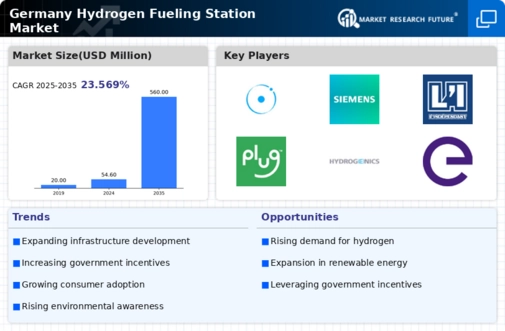The Germany Hydrogen Fueling Station Market is rapidly evolving, driven by the increasing emphasis on sustainable energy solutions and the push towards decarbonization in the transportation sector. As the government commits to ambitious climate targets and the expansion of electric vehicles, hydrogen fuel stations emerge as pivotal infrastructure in this transition. The market is characterized by a variety of players, each contributing to the growth in different ways, be it through technological advancements, strategic partnerships, or investment in infrastructure.
Competitive insights reveal a landscape where innovation, regulatory compliance, and collaboration with municipalities and private enterprises are crucial for success. Companies that can leverage advancements in hydrogen production, storage, and distribution technologies are positioning themselves favorably within this burgeoning sector.GKN Hydrogen, a key player in the Germany Hydrogen Fueling Station Market, has established a strong presence through its commitment to developing advanced hydrogen solutions tailored to meet the specific needs of the region. The company leverages its engineering expertise to create efficient and reliable fueling infrastructure, catering to the growing demand for hydrogen fuel usage in transportation.
GKN Hydrogen has focused on integrating its systems seamlessly into the existing energy landscape, enhancing operational efficiency while ensuring safety and sustainability. Their emphasis on innovation, coupled with strategic partnerships with local authorities and industry stakeholders, empowers them to respond quickly to emerging market needs. This ability to adapt alongside the evolving regulatory environment enhances GKN Hydrogen's competitive edge within the German hydrogen sector.ITM Power is another prominent entity in the Germany Hydrogen Fueling Station Market, known for its extensive experience in electrolyser technology and hydrogen production solutions.
The company offers a range of key products and services that allow the creation of hydrogen through renewable energy, supporting the sustainability initiatives prevalent in Germany.
ITM Power's robust market presence is further strengthened by collaborations with both governmental and private organizations that facilitate the deployment of hydrogen fueling stations. Their strategic approach includes not only establishing new stations but also improving existing infrastructure to enhance the overall efficiency of hydrogen utilization. Over recent years, ITM Power has expanded its footprint in the region through mergers and acquisitions, positioning itself for a forecasted increase in hydrogen demand as Germany works towards its carbon neutrality goals.
This proactive strategy ensures that ITM Power remains a significant player in driving the transition towards a hydrogen-based economy in the country.


















